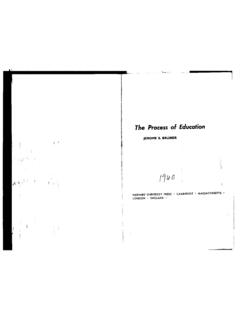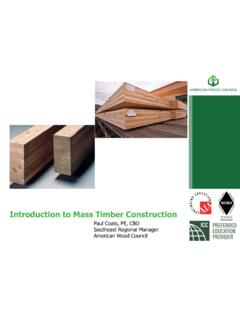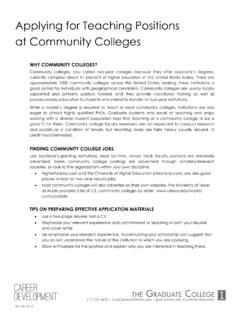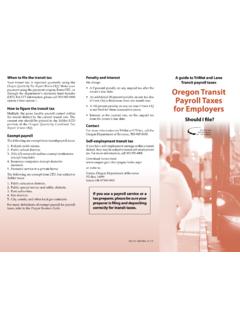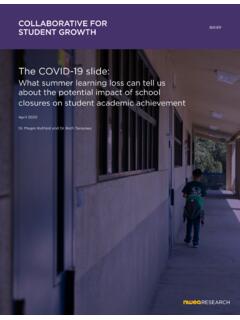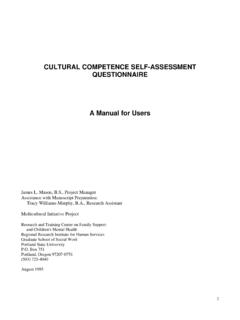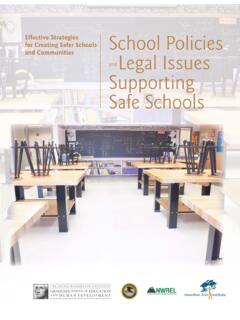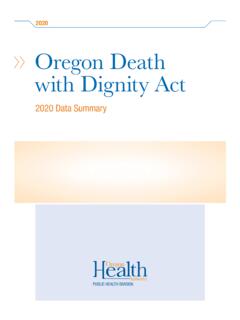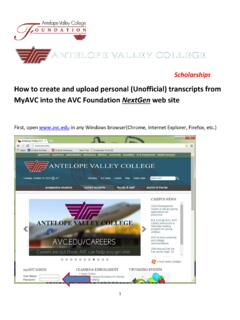Transcription of THE MULTIGRADE CLASSROOM
1 THE MULTIGRADE CLASSROOM : A RESOURCE HANDBOOK FOR SMALL,RURAL SCHOOLSBook 2: CLASSROOM OrganizationNovember 1999 Rural education ProgramBased on the September 1989 publication of the same title written by Bruce A. MillerSusan Vincent, EditorJoyce Ley, DirectorNorthwest Regional Educational Laboratory101 Main Street, Suite 500 Portland, oregon 97204 The following selections have been reprinted with permission:Cohen, E. (1986). Designing groupwork: Strategies for the heterogeneous class-room(pp. 207 209). New York, NY: Teachers College Press. (Reprintedwith permission of publisher.)Emmer, (1987). CLASSROOM management and discipline. In & Berliner (Eds.), Educators handbook: A research perspective (pp. 233-258). White Plains, NY: Longman.(Reprinted with permission of publisher.)Evertson, , Emmer, , Clements, , Sanford, , & Williams, E.
2 (1981). Organizing and managing the elementary school ,TX: University of Texas, Research and Development Center for TeacherEducation. (Reprinted with permission of Carolyn Evertson, PeabodyCollege, Vanderbilt University, Nashville, TN.)Gaustad, J. (1994). Nongraded education : Overcoming obstacles to imple-menting the MULTIGRADE CLASSROOM [Special issue].OSSC Bulletin, 38(3& 4). (Reprinted with permission of author.)Gibbons, M., & Phillips, G. (1978). Helping students through the self- education crisis. Phi Delta Kappan, 60(4), 296 300. (Reprinted withpermission of publisher.)Kagan, S. (1989). Cooperative learning: Resources for teachers. San JuanCapistrano, CA: Resources for Teachers. (Reprinted with permission of publisher.)Karweit, N. (1987). Diversity, equity, and CLASSROOM processes. In (Ed.), Social organization of schools: New conceptualizations of thelearning process(pp.)
3 71 102). New York, NY: Plenum Press. (Reprintedwith permission of publisher.)Kentucky Department of education . (1996). Nearly all Kentucky schools showimprovement in latest KIRIS scores, but middle schools lag behind[Pressrelease]. Frankfort, KY: Author. (Reprinted with permission of author.)Murphy, J., Weil, M., & McGreal, T. (1986). The basic practice model school Journal, 87(1), 83 96. (Reprinted withpermission of the University of Chicago Press.) oregon Department of education , & Ackerman Laboratory school . (1994).Mixed-age programs, 1993 94. Salem, OR: oregon Department ofEducation. (Reprinted with permission of publisher.)Pavan, (1992). The benefits of nongraded schools. EducationalLeadership, 50(2), 22 25. (Reprinted with permission of author.)iiAcknowledgmentsThe MULTIGRADE ClassroomSlavin, (1987). Ability grouping and student achievement in elemen-tary schools: A best-evidence synthesis.
4 Review of Educational Research,57(3), 293 336. (Reprinted with permission of the AmericanEducational Research Association.)Slavin, (1988). Synthesis of research on grouping in elementary andsecondary schools. Educational Leadership, 46(1), 67 77. (Reprintedwith permission of the Association for Supervision and CurriculumDevelopment.)Slavin, , & Madden, (1989). What works for students at risk: A research synthesis. Educational Leadership, 46(5), 4 13. (Reprintedwith permission of the Association for Supervision and CurriculumDevelopment.)Thomas, , Strage, A., & Curley, R. (1988). Improving students self-directed learning: Issues and guidelines. Elementary school Journal, 88(3),313 326. (Reprinted with permission of the University of Chicago.)iiiivOverviewThe MULTIGRADE ClassroomPrefaceThe preface describes the process used in developing this handbook,including the MULTIGRADE teachers who shared their CLASSROOM strategiesand ideas for improving the usefulness of the history of MULTIGRADE CLASSROOM instruction is presented, alongwith the background information that describes why multigradeinstruction is an important and complex issue for 1: Review of the Research on MULTIGRADE InstructionIn this book, the research on MULTIGRADE instruction is reviewed in order to answer two questions: (1) What effect does multigradeinstruction have on student performance?
5 And (2) What kind of train-ing is needed in order to teach in a MULTIGRADE CLASSROOM ? Detailedinformation focusing on organizing and teaching in a MULTIGRADE class-room is also 2: CLASSROOM OrganizationThis book describes strategies for arranging and organizing instruc-tional resources and the physical environment of the CLASSROOM . Sampleclassroom layouts and a design kit for organizing your CLASSROOM arealso 3: CLASSROOM Management and DisciplineEstablishing clear expectations for student behavior and predictableclassroom routines has been shown to improve student this book, research relating to CLASSROOM management and disciplineare presented, along with a checklist for planning management routinesand discipline 4: Instructional Organization, Curriculum, and EvaluationResearch-based guidelines for planning, developing, and implementinginstructional strategies are presented.
6 This book emphasizes the devel-opment of cooperative work norms in the MULTIGRADE CLASSROOM andexplains how to match instruction to the needs of students. An overviewof curriculum and evaluation planning concepts is also provided. Thisbook is a close companion piece with book 5: Instructional Deliveryand 5: Instructional Delivery and GroupingThis book emphasizes that instructional quality and student groupingare key components for success in the MULTIGRADE methods such as recitation, discussion, and cooperativelearning are reviewed. Planning guides and examples are also includedwhere appropriate. Strategies for organizing group learning activitiesacross and within grade levels, especially those that develop interde-pendence and cooperation among students, are 6: Self-Directed LearningDeveloping skills and strategies in students that allow for a high levelof independence and efficiency in learning, either individually or incombination with other students, is essential in the MULTIGRADE class-room.
7 Ideas for developing self-direction are presented in this 7: Planning and Using Peer TutoringThis book provides guidelines for developing skills and routines wherebystudents serve as teachers to other students within and across differ-ing grade levels. The research on what makes for effective tutoring inthe CLASSROOM is also MULTIGRADE ClassroomThe development of this handbook began in 1987, when a group of people involved in rural education raised several issues regardingmultigrade CLASSROOM their discussions, members of the advisory committee for theNorthwest Regional Educational Laboratory s (NWREL) Rural EducationProgram agreed that MULTIGRADE teacher training in their respective stateswas either lacking or wholly inadequate. They also were concerned aboutthe availability of research and training materials to help rural multigradeteachers improve their a result of these concerns, the Rural education Program decided todevelop a handbook to assist the MULTIGRADE teacher.
8 The handbook evolvedin several stages. The first was a comprehensive review, conducted by Miller, of the research on MULTIGRADE instruction that included articles,books, and research reports from the United States, Canada, Australia, andother this review, six topic areas emerged that are considered essential foreffective MULTIGRADE instruction: CLASSROOM organization; CLASSROOM manage-ment and discipline; instructional organization, curriculum, and evaluation;instructional delivery and grouping; self-directed learning; and planning andusing peer tutoring. Dr. Miller developed the handbook around these sixinstructional areas, and a draft was completed in June 1989, with supportfrom the Office of Educational Research and Improvement (OERI).The second stage occurred in July 1989, when a conference was held inAshland, oregon , with MULTIGRADE teachers who were recommended by educa-tional leaders from throughout the Northwest and Pacific Island the conference, participants were organized into workgroups,each focusing on one of the topic areas.
9 Their tasks were to review theappropriate handbook chapter for clarity and content, to suggest alternativeand/or additional instructional strategies to those presented in the handbook,and to write case descriptions of activities drawn from their classrooms. For example, Joel Anderson from Onion Creek Elementary in Colville,Washington, described how he grouped students for cooperative Shane from Vida, Montana, presented a school handbook she haddeveloped for parents that included a class schedule and other school -relatedinformation. (A full list of participants appears at the end of this preface.)The final handbook was completed by Dr. Miller in September on the growing interest and research on MULTIGRADE instructionthe handbook was revised and updated in 1999, also with support fromOERI. The final version, completed with support from the Institute ofInternational education (IIE), is now composed of a series of seven stand-alone 1: Review of the Research on MULTIGRADE InstructionBook 2: CLASSROOM OrganizationBook 3: CLASSROOM Management and DisciplineBook 4: Instructional Organization, Curriculum, and EvaluationBook 5: Instructional Delivery and GroupingBook 6: Self-Directed LearningBook 7: Planning and Using Peer TutoringPurpose and Scope of the HandbookThe handbook has been written to serve three general purposes.
10 L To provide an overview of current research on multigradeinstructionl To identify key issues teachers face when teaching in a multi-grade settingl To provide a set of resource guides to assist novice and experienced MULTIGRADE teachers in improving the quality of instructionHowever, because of the complexity of MULTIGRADE instruction and thevast amount of research on effective CLASSROOM instruction, this handbookcan only serve as a starting point for those educators wanting to learn newskills or refine those they already book of the series presents information, strategies, and resourcesconsidered important for the MULTIGRADE teacher. While all the books arerelated, they also can stand alone as separate documents. For example, thebooks on CLASSROOM Organization (Book 2) and CLASSROOM Managementand Discipline (Book 3) contain overlapping information.










